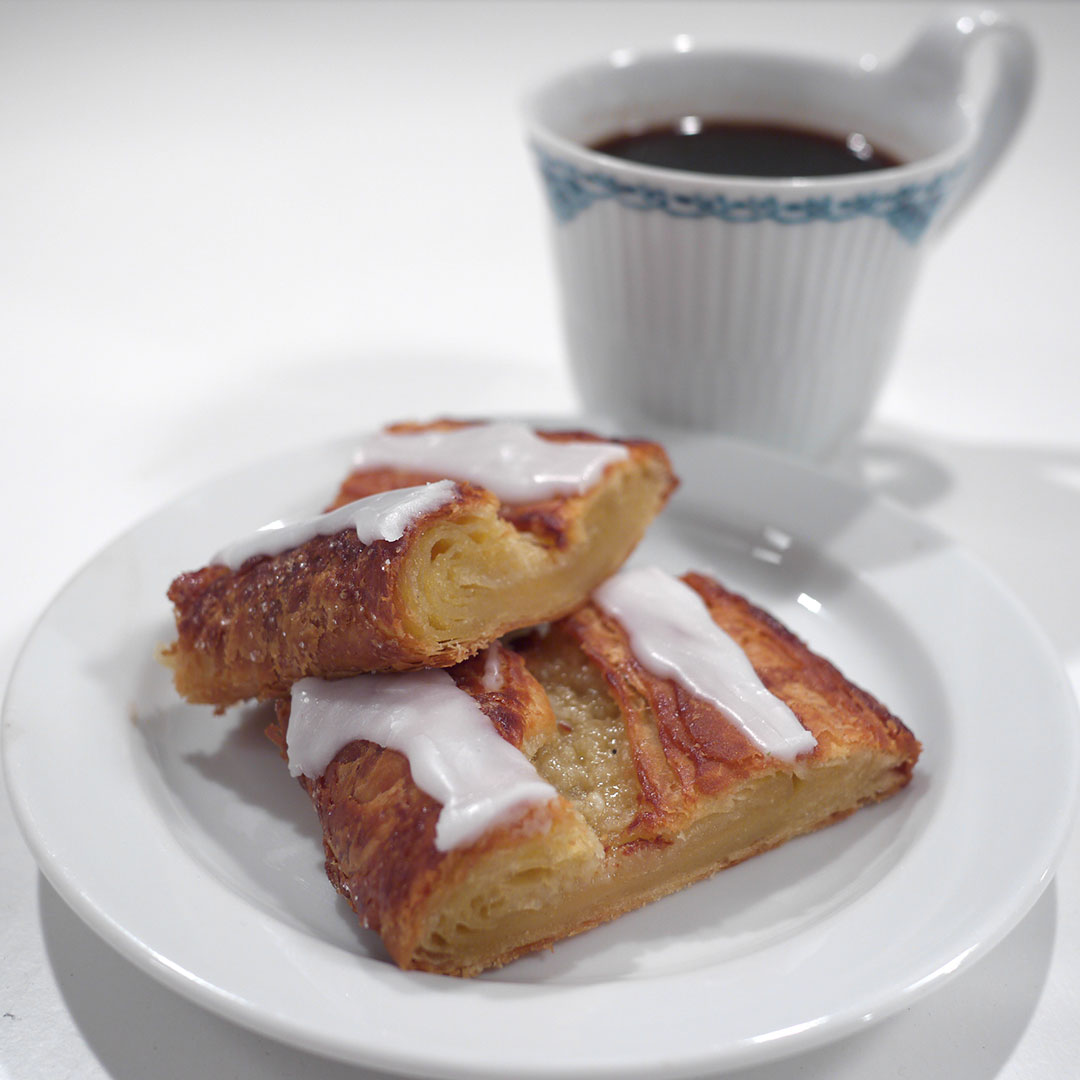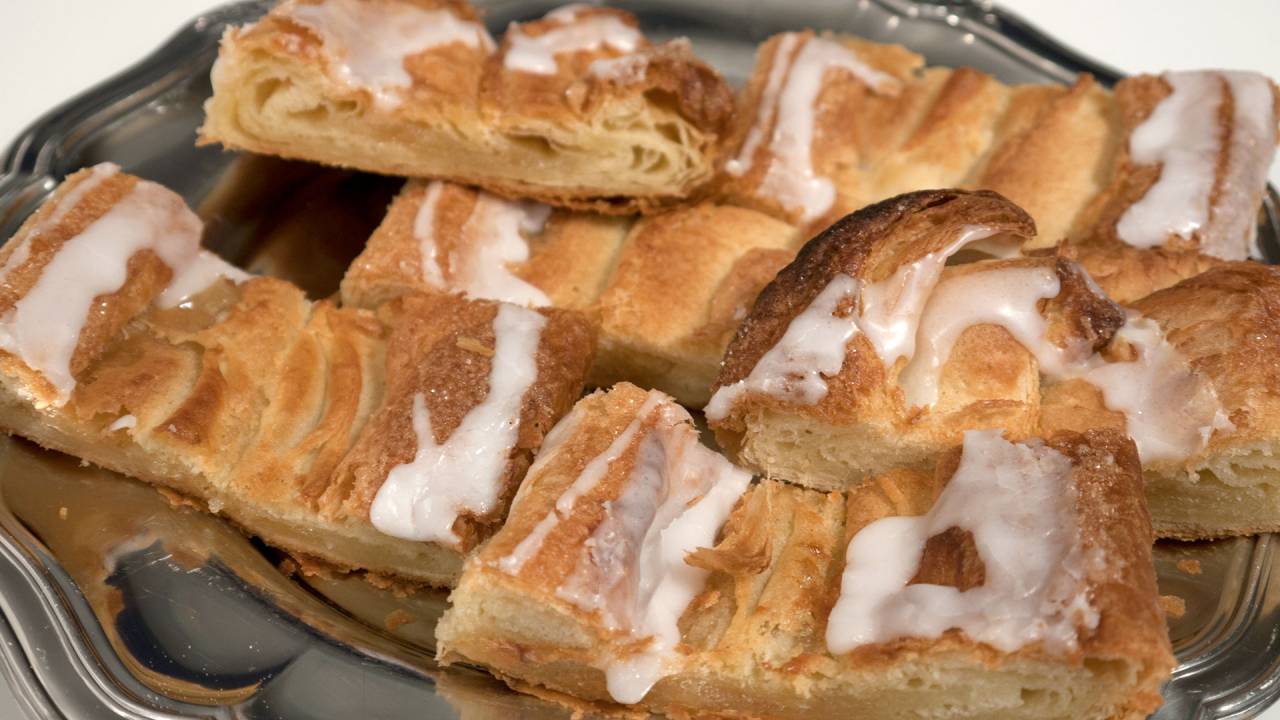Danish pastry - base recipe - danish pastry bar

Ingredients
(3 bars or 16 pieces)
Pastry dough
- 13.5 oz (375 grams) flour
- 7 oz (200 grams) milk, cold
- 1 oz (25 grams) of fresh yeast or 0.3 oz (8 grams) of instant yeast. I believe that to be about a tablespoon full.
- 1½ oz (40 grams) of sugar
- 2 oz (50 grams) butter
- 1 egg
Folding butter / lamination butter
- 14 oz (375 grams) butter (1 part butter to 2 parts dough (I did not say it was healthy ...))
Remonce
- 2 oz (50 grams) butter
- 2 oz (50 grams) of sugar
- 2 oz (50 grams) of marzipan (homemade marzipan recipe)
Egg wash
- 1 egg, beaten
- 1 tablespoon water, mølk or cream whipped with egg
- ½ cup sugar
Directions
Remonce part #1
Mix all the ingredients for the remonce and put it aside.
The dough
Take the butter for the dough out of the fridge in good time so that it becomes soft. Or buzz it for 10-20 seconds in the microwave.
Hand kneading
Mix milk, yeast, sugar, egg and butter.
Add the flour while mixing with a spatula or your hands. Knead it for 3-4 minutes until it hangs together well and there are no dry lumps.
It is a relatively wet dough that will stick to your fingers, so it is easiest to do it in a machine.
Machine kneading
Mix all the ingredients except butter and flour.
Add 2/3 of the flour.
Add the soft butter.
When it is well incorporated into the mix add the rest of the flour
Put plenty of flour on your table to prevent the dough from sticking.
Form the dough into a ball by folding it into itself from below.
Put aside and let it rise to twice the size. ½ -1 hour.
Making the folding layers / laminating the dough
Put plenty of flour on the table.
Work the butter soft by continuing the below cycle
BUTTER CYCLE START
Collect all the butter into a single lump.
Flour the butter generously.
Knock it flat with your rolling pin.
BUTTER CYCLE END
Stop when the butter has the same consistency as the dough. They are to be folded together later, which is a lot easier when that do have the same consistency.
Folding of the layers
But the dough back on the floured and roll our four flaps. One from each corner.
Each flap must be the same length. And the same length as the center square.
Shape the butter lightly until it is of the same size as the middle piece.
Put the butter in the middle of the dough and fold the four flaps over the butter until it is totally enclosed.
Turn over the dough so that the flaps are against the table.
Loosely flatten the dough with your hands.
DOUGH CYCLE START
Roll the dough into a long rectangle, 1 length wide and 3 lengths long.
Fold it into 3 layers. A so-called "3 fold".
Repeat it all two more times.
DOUGH CYCLE START
So in total it is folded:
- fold (3 layers of butter)
- fold (9 layers butter)
- fold (27 layers of butter)
If the dough is very eleastic and continues to spring back when you roll it out, you should let it rest a cool place for 5-20 minutes between each fold. Depending on what is needed. That will make it a lot easier to work with.
If your kitchen is hot you should let the dough rest in the fridge, to prevent it from rising too much.
Final rollout
Roll out the dough to a size of 16" x 16" (40cm x 40cm). It is important to be reasonably accurate. Use some kind of measurement device.
Cut the dough into 3 strips.
Shaping the bars
Remonce part #2
Split the remoncen into 3 equal portions of 2 ounces (50 grams).
Put the remoce in the center of each strip. I usually hold it in my fist and then put it on with my thumb and forefinger. A little at a time.
Stop the remonce before you reach the end of the strip.
Final shaping
Fold the ends of the strip over remoncen.
Then fold the sides of the dough over the remonce.
Press down the dough firmly with the edge of your hand. Almost through to the table.
Brush the shaped bars with the egg wash and sprinkle liberally with sugar.
Let the bars rise to about double size. ½ -1 hour.
You can let the dough rise at room temperature. But if the temperature is high enough to melt the butter, you should put in the fridge part of the time. Otherwise the butter layers will disappear into the dough and you will get no laminiation. And that is boring!
So you should not use any "tricks" with heat to let the dough rise faster.
Convection oven: bake at 350°F (180° C) for 25-30 minutes.
Normal oven: bake at 400°F (200° C) for 25-30 minutes.
Notes
If the rolling butter is too soft or too warm when you do the folding you will push it out through the dough.
If the butter is to hard it will poke holes in the dough.
If either happens you should put on plenty of flour on the broken spot an continue rolling and folding. Then cool or rest as needed.
The mistake that is most often made when folding danish pastry is to roll it to hard, so that the butter is pressed into the dough. That will destroy the laminiation, and you will not get those flaky layers.

Your egg wash recipe indicates you mix a 1/2 cup of sugar with one egg and a tablespoon of milk but your video shows you only dusting the bars with sugar after you apply the egg wash. Are you putting more sugar on or is that the 1/2 cup of sugar you called out in your egg wash?
Also, do you use salted or unsalted butter?
Thank you Max I'm from Egypt and I try danish pastry...my family love it
Danish pastry bar
Excellent, my wife is from Lithuania and she said that she loved it. We like the Danish method I am going to make the Danish pastry again it is flakey, buttery and so delicious she almost didn't believe that I made it! Thanks for sharing. All The Best, Cre LombardiWienerbrod
Hi Max: My mother (Mor) was from Denmark and I travelled there 9 times while growing up in the 60's and 70's. My last visit was in 1986. We used to go to the local bakery and buy Tebirkes with the remounce. I am a baker and have never been able to find a good recipe in english, any ideas? I really appreciate your help. I found a terrific recipe for Weinerbrod in an older cookbook called the Cooking of Scandinavia. It was published by Time Life Books, one in series of books on cooking around the world. Mom also had a terrific book called Take a Silver Dish. They are both great references for the real Danish cooking of my childhood. Thanks so much for giving me a resource for authentic Danish recipes. I still regularly make cucumber salad, frikadeller and boller i karry, grav lax, and have even made my own rugbrod. I wish I could make really good fiske frikadeller like my Mor Mor used to make. Mine is good but not as good as hers.Not sure how long ago you left this question, but I noticed that he does have a Tebirkes recipe.
:)
